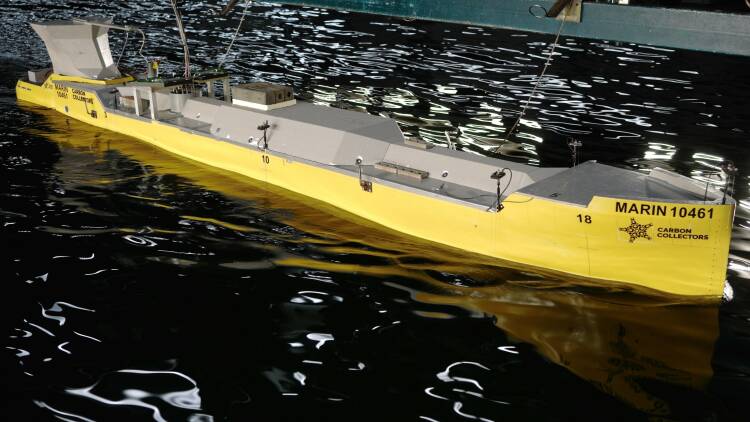



News
Carbon Collectors
Bubble curtains
Floating wind
Wind statistics
Operational advice
Floating Future
Crabbing
Cover
More info
October 2023, no. 137

Create a MARIN account to stay updated
Report
In a stride towards advancing sustainable energy solutions, Carbon Collectors, a partner in the research project LNG-ZERO, has embarked on an innovative endeavour.
The focal point of this innovation revolves around a novel shipping concept, facilitating the collection, transportation and injection of carbon dioxide (CO2) into depleted gas reservoirs within the Southern North Sea. This concept transforms an out-of-use offshore gas field into a permanent CO2 storage facility, mitigating industrial CO2 emissions.
Carbon Collectors has been examining the concept thoroughly using the diverse capabilities offered by MARIN. In 2022, the operational feasibility was first confirmed by bridge simulations and once the concept matured, design validation and optimisation were carried out using model tests and numerical modelling.
The concept entails the transportation of CO2 via an Articulated Tug Barge (ATB) arrangement. The barge delivers the CO2 to the offshore Tower Loading Unit (TLU), through which the carbon dioxide is pumped underground into a depleted gas reservoir. This innovative approach circumvents the reliance on fixed platforms and pipelines for storage access, thereby streamlining operations and broadening the range of storage locations.

Figure 2. Scale model of the ATB combination in waves.
Haije Stigter,
Technical Director Carbon Collectors

Michiel Brouwer,
CFO Carbon Collectors

Figure 1. Wave pattern at the stern of the ATB combination (underwater view) and around the ATB combination (bird view).
At MARIN the journey of Carbon Collectors towards the realisation of the ATB concept encompassed a comprehensive assessment programme, incorporating simulations and model analyses executed in a multidisciplinary framework. In order to assess its operational viability, the ATB was tested on MARIN’s simulators. These initial bridge simulations yielded positive outcomes, confirming the operational feasibility of the ATB.
Additionally, MARIN helped refine the hull shape to reduce water resistance. Computational Fluid Dynamics (CFD) calculations were instrumental in optimising the hull's geometry to ensure a streamlined and efficient maritime transit (see figure 1).
When the concept design was nearly finalised, the design’s manoeuvring capabilities and its seakeeping behaviour in various sea conditions were validated using model tests in MARIN’s Seakeeping and Manoeuvring Basin (see figure 2).
Integration of pusher and streamlined barge
Central to the ATB concept is the integration of the pusher and the streamlined barge, a fusion that yields a unified appearance akin to a single, dynamically streamlined vessel. This is enabled through the tailored design of the barge's stern, which is attuned to the contours of the pusher vessel.
Another innovative facet involves the utilisation of an additional barge as intermediate storage. While the ATB sets its course towards an offshore CO2 storage location, additional barges are used for storing carbon dioxide emitted from the factory. This approach circumvents the necessity for the factory to invest in independent, intermediate storage infrastructure. Upon the ATB’s return from its offshore journey, the filled barge is swapped with the empty one. This ensures an unbroken cycle of carbon capture, enabling a continuous approach to mitigating carbon emissions.



More info

Figure 2. Scale model of the ATB combination in waves.
Haije Stigter,
Technical Director Carbon Collectors

At MARIN the journey of Carbon Collectors towards the realisation of the ATB concept encompassed a comprehensive assessment programme, incorporating simulations and model analyses executed in a multidisciplinary framework. In order to assess its operational viability, the ATB was tested on MARIN’s simulators. These initial bridge simulations yielded positive outcomes, confirming the operational feasibility of the ATB.
Additionally, MARIN helped refine the hull shape to reduce water resistance. Computational Fluid Dynamics (CFD) calculations were instrumental in optimising the hull's geometry to ensure a streamlined and efficient maritime transit (see figure 1).
When the concept design was nearly finalised, the design’s manoeuvring capabilities and its seakeeping behaviour in various sea conditions were validated using model tests in MARIN’s Seakeeping and Manoeuvring Basin (see figure 2).
Figure 1. Wave pattern at the stern of the ATB combination (underwater view) and around the ATB combination (bird view).
Integration of pusher and streamlined barge
Central to the ATB concept is the integration of the pusher and the streamlined barge, a fusion that yields a unified appearance akin to a single, dynamically streamlined vessel. This is enabled through the tailored design of the barge's stern, which is attuned to the contours of the pusher vessel.
Another innovative facet involves the utilisation of an additional barge as intermediate storage. While the ATB sets its course towards an offshore CO2 storage location, additional barges are used for storing carbon dioxide emitted from the factory. This approach circumvents the necessity for the factory to invest in independent, intermediate storage infrastructure. Upon the ATB’s return from its offshore journey, the filled barge is swapped with the empty one. This ensures an unbroken cycle of carbon capture, enabling a continuous approach to mitigating carbon emissions.
Michiel Brouwer,
CFO Carbon Collectors

Carbon Collectors has been examining the concept thoroughly using the diverse capabilities offered by MARIN. In 2022, the operational feasibility was first confirmed by bridge simulations and once the concept matured, design validation and optimisation were carried out using model tests and numerical modelling.
The concept entails the transportation of CO2 via an Articulated Tug Barge (ATB) arrangement. The barge delivers the CO2 to the offshore Tower Loading Unit (TLU), through which the carbon dioxide is pumped underground into a depleted gas reservoir. This innovative approach circumvents the reliance on fixed platforms and pipelines for storage access, thereby streamlining operations and broadening the range of storage locations.
The focal point of this innovation revolves around a novel shipping concept, facilitating the collection, transportation and injection of carbon dioxide (CO2) into depleted gas reservoirs within the Southern North Sea. This concept transforms an out-of-use offshore gas field into a permanent CO2 storage facility, mitigating industrial CO2 emissions.
In a stride towards advancing sustainable energy solutions, Carbon Collectors, a partner in the research project LNG-ZERO, has embarked on an innovative endeavour.




October2023, no. 137
Report








